
Top Best Crypto Hardware Wallets
Cryptocurrencies are digital currencies spent on decentralized networks. Like individuals store fiat currencies in physical wallets, cryptos are individually kept in a digital wallet where they are spent from or exchanged with other users. Like fiat money held in a wallet can be stolen by a pickpocket, digital currencies can also be siphoned from wallets by adversaries. Safety against theft and cyber-attacks on crypto wallets led to the invention of cold wallets. A crypto wallet can be a software or hardware wallet regarding its functionalities
- A software wallet is an online crypto wallet hosted in the web space. It is also called a hot wallet because using and interacting with it requires an internet connection. A software wallet can be a custodial or non-custodial wallet.
A custodial wallet is hosted by crypto exchanges or third parties like Binance, ByBit, KuCoin, Gemini, Coinbase, Gate, etc.
Non-custodial wallets are web 3 wallets that exist separately outside crypto exchanges but require the internet to function. Examples of non-custodial wallets include MetaMask, Trust Wallet, Coinbase, Frame WalletConnect, etc.
Hot wallets are susceptible to cyber-attacks and SPOA (Single Point of Attack); if exchanges where they are hosted, are under cyber-attacks, all wallets hosted on the attacked exchange are not safe.
2. A hardware wallet is an offline crypto wallet that stays off the web. It is also called a cold wallet since it doesn’t need the internet to function. It is considered highly secure because it is not connected to the web, thereby eliminating the risks of being hacked.
Hardware wallets are also categorized as non-custodial wallets because no third party or centralized entity has access to them except their holders. They exist as a device that can be connected to mobile devices or desktop computers. Various hardware wallets have varying functionalities as different companies invent them. Below are examples of the top best hardware wallets.
1. Ledger Nano Wallets
The Ledger Nano wallets are hardware wallets for storing crypto tokens. The wallets were invented by a French company, Ledger, which was co-founded by Éric Larchevêque, Joel Pobeda, Nicolas Bacca, and Thomas France in 2014. The Ledger company is a significant player in HSM (Hardware Security Modules) and crypto security. Their wallets are Ledger Nano S and Nano X.
Ledger Nano S Plus
If you are a Ledger Nano fan, you will love the Ledger Nano S Plus. This hardware wallet is an updated version of the Ledger Nano S and Nano X hardware wallets.
As you would expect, it comes with the same form factor as its predecessors but with tons of changes. For starters, you get a larger screen wrapped around a sleek, sturdy device.
Anyone who owns multiple coins and is looking for a multi-signature hardware wallet will find the Ledger Nano S Plus quite useful. Its hard drive can hold up to 100 cryptocurrencies, this includes tokens and NFTs.
In terms of security, the Ledger Nano S Plus features the same Certified Secure Element (CC EAL5+) level of encryption that is available on other Ledger Nano devices.
Over the years, Ledger Nano’s devices have proven to be the gold standard for security in the crypto world, and the Ledger Nano S Plus continues this proud tradition. With the CC EAL5+ level of encryption, it ensures your assets are stored with the highest level of protection possible against both physical and digital threats.
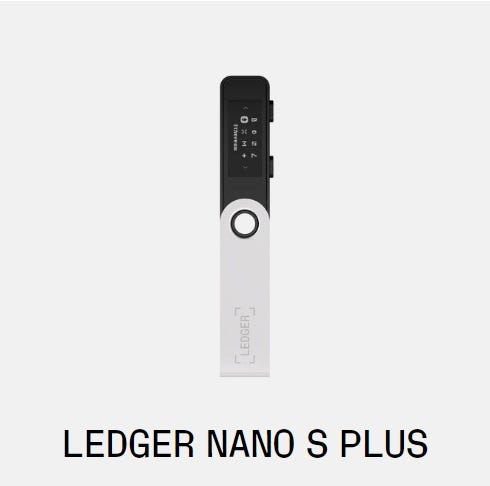
Ledger Nano X
The Ledger Nano X wallet is an upgrade of the Nano S wallet that was released in 2019. It shares similar features with the former alongside additional features like Bluetooth connectivity and a lasting battery (up to 8 hours). It is compatible with iOS and other devices, as with Nano S. It also has a better resolution, larger screen, and bigger navigation buttons than the Nano S.
Nano S and X have the same security measures, manage over 1800 crypto tokens, and support ERC-20, ERC-721 (NFT), BEP-2, TRC-20, TRC-10, SOL, and NEP-5 token standards. It supports tokens like BTC, ETH, BNB, LTC, ADA, LINK, XLM, DOT, DOGE, TRX, etc. In April 2022, a slight upgrade was made to the Nano S wallet leading to another Nano S Plus wallet. The Nano X wallet costs $149, while Nano S costs lesser.

Ledger Staxx
Ledger just recently released Ledger Stax as the company’s new hardware wallet designed for the “day-to-day” use of crypto and NFTs.
The wallet is completely different from the old Ledger devices and comes in the shape of a sleek palm-sized device with a touch screen that is altogether built for comfort. Ledger Staxx is by far the largest display on any hardware wallet. You can personalize the wallet with pictures of the NFTs you hold.
The wallet was designed by Tony Fadell who is an iPhone co-creator. As iit seems, Ledger Stax is pushing the boundary of what a hardware wallet should be. It offers more than a tool for storing private keys and presents its users an interface through which they can interact with all sorts of Web 3.0 applications.
With Ledger Stax, users get faster verification when they sign in or verify their identity across Web 3.0 applications.

2. Trezor Wallets
Trezor wallets are another of top best cold storage wallets invented by SatoshiLabs Group (co-founded by Alena Vranova, Pavol Rusnak, and Marek Palatinus on December 12, 2013). Like the Ledger, Trezor wallets are also in two editions; Trezor One and Trezor Model T.
Trezor One
The Trezor One hardware wallet was the premiere commercial hardware wallet compatible with 1,000+ crypto tokens. The lightweight (12g) device was released in January 2014, and it is equipped with a USB port for connecting the device to a mobile phone (Android) or desktop computer (Windows, Linux, and macOS). It features a monochrome display with two buttons for navigation. The wallet supports multiple transactions in a single operation, i.e., users can execute batch transactions in a single process. It supports cryptos like BTC, ETH, LTC, BCH, ETC, BTG, XRP, USDT, XLM, DASH, ZCASH, etc.
Regarding security, the Trezor One wallet features a 24- word backup phrase with an additional custom 1-word as extra security if your 24-word seed phrase has been compromised. This means users can add an extra phrase to the backup phrase to make it a 25-word seed phrase. It also has 9 digits PIN protection with a 2-second delay if wrong PINs are entered successively to prevent brute force. Its security is also beefed with a multi-signature to prevent SPOF (Single Point of Failure). The wallet costs $59.
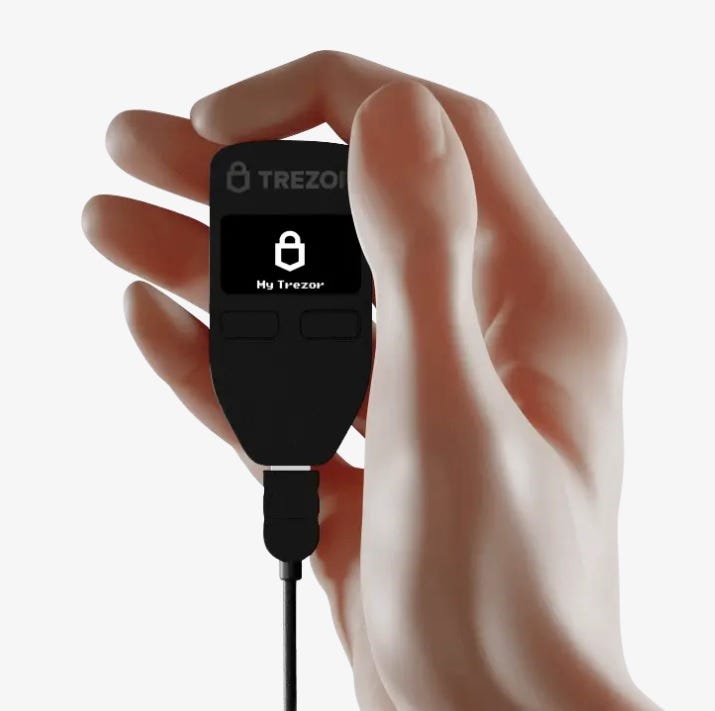
Trezor Model T
The Trezor Model T wallet is the second edition of the Trezor wallet, released on February 26, 2018. It can be regarded as an upgrade of the Trezor One wallet because they share similar features. The Trezor Model T wallet has the same security and token compatibility as its predecessor wallet. As an upgrade, the Model T has a larger screen, size, and weight (22g), alongside a Type-C USB. Aside from that, the Model T has no navigation buttons but a touchscreen for easy navigation and a bright color LCD (Liquid Crystal Display).
In its advantage over Trezor One, the Model T wallet has an SD card slot for storing and encrypting passwords. Also included in the Model T is the exchange tab that allows users to trade crypto tokens from exchanges. The wallet costs $159.

3. NGRAVE ZERO
The NGRAVE ZERO wallet is another great hardware wallet dubbed “The Coldest Wallet” and released on May 26, 2020. It is the brainchild of NGRAVE; a Belgian crypto security company co-founded by Ruben Merre (CEO), Xavier Hendrickx (CTO), and Edouard Vanham (COO) in 2018. The ZERO wallet is dubbed “The Coldest Wallet” because it is a fully air-gapped wallet requiring no Wi-Fi, NFC, USB, or Bluetooth connection. Instead, it uses QR code technology and a corresponding mobile app to execute transactions.

The wallet is a pocket-size touchscreen military-grade device with a fingerprint sensor, camera, light sensor, LCD screen, Type-C USB charging cable, and On/Off button. It is dust, water-resistant, and tamper-resistant due to its dual casing (inner and outer). It runs on its custom OS and comes with NGRAVE LIQUID, a mobile app to securely sign transactions and manage your portfolio.
Regarding security, the ZERO wallet is the only cold wallet that is EAL7 certified, and it comes with 2 GRAPHENE metal plates and a puncher to secure the wallet’s private key dubbed “Perfect key.”
What is a Perfect Key?
A Perfect Key is a real-time unique private key generated randomly through your fingerprint, shuffling keys, and the in-built light sensor. The light sensor measures users surrounding light and considers their immediate environment to create random private keys. This shows the device doesn’t have a pre-set private key, making it secure and confidential. The Perfect Key is a 64-hexadecimal (0–9; A-F) character equivalent to a 24-word seed phrase.
What about the GRAPHENE Metal Plates?
The GRAPHENE metal plates are two stainless-steel plates that weigh 682g. They are resistant to fire, corrosion, shock, or floods. They replaced the traditional methods of storing private keys because both plates are encrypted and can only show your key when used together. The upper plate has unique alphanumeric combinations and a unique code that can be used to order a new plate if they lose it or need an extra copy. The bottom plate records the punched alphabet or number, which can only be revealed when placed underneath the corresponding upper plate. Keeping both plates in separate locations will reduce the chance of a third-party intrusion.
The ZERO wallet supports 13 blockchains and cryptocurrencies like BTC, ETH, BNB, BCH, XRP, LTC, ZEC, and over 1,500 ERC-20 tokens. It also supports ERC-721 (NFTs minted on the Ethereum network) with plans to accommodate NFTs from other networks soon. The ZERO wallet alone costs €398, while the wallet alongside the GRAPHENE plates and a puncher costs €498.
4. SafePal S1
The SafePal S1 wallet is another air-gapped cold wallet released in May 2018. SafePal was co-founded by Veronica Wong (CEO), Harry Zhang (CPO), and Leaner Zhang (CTO) in January 2018, and it received a strategic investment from Binance Labs in October 2018. The S1 wallet is a pocket-size hardware wallet compatible with 54 blockchain networks and 30,000+ crypto tokens, including BTC, LTC, ETH, BNB, DOGE, LINK, etc., and supports 15 languages.
The S1 wallet has no Bluetooth, Wi-Fi, NFC, or USB connection for optimum security from adversaries. Its Type-C USB port and cable charge the device’s 400mAh that can last 20 days if used for 10 minutes daily. It connects with mobile phones (Android and iOS) through QR technology using its in-built camera. The device has navigation buttons and a 1.3′ IPS (In-Plane Switching) screen, reflecting an LCD sandwiched between two glass surfaces.
Regarding security, the S1 wallet is EAL 5+ certified and has multiple security sensors with a self-destruct mechanism during any hacking attempt. Furthermore, it offers a Cypher Seed Protection Board that is resistant to fire, water, or acid, for backing up and securing mnemonic phrases. The standard package (S1 + Leather case) costs $59.98, while the Hardcore Bundle (S1 + Cypher) costs $90.48, and the Expert’s Choice (S1 +Cypher + Leather case) costs $100.47.
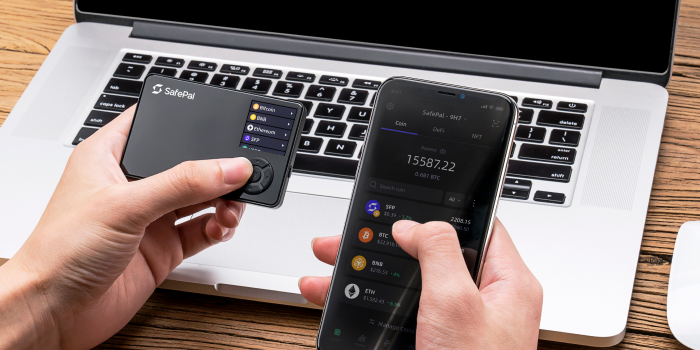
5. ELLIPAL Titan
ELLIPAL Titan wallet is another top-rated hardware wallet released in August 2019 by ELLIPAL, a Hong Kong-based company co-founded by David Tian and Thomas in 2018. The Titan wallet is one of the premiere air-gapped cold wallets with a large screen display (4 inches). It is also the first fully metal-sealed cold wallet against anti-tamper. It automatically self-destructs to restore factory settings when tampered with. Its app is compatible with Windows, Mac, and mobile phones (Android and iOS).
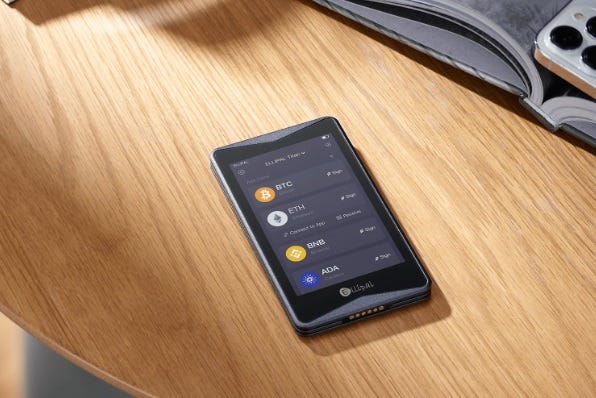
The Titan wallet supports NFTs and cryptocurrencies like BTC, ETH, BNB, USDT, XRP, ETC, BCH, ADA, and over 10,000 crypto tokens. It is EAL 5+ certified and equipped with a 2FA (PIN & password) security module, and its firmware update is 100% offline through a micro SD card. The wallet is uniquely equipped with a dummy account that appears when you unlock your wallet with an alternate password when under duress. This dummy account is referred to as an alternate account that is called when the alternate password is entered. The aluminum alloy wallet has a battery rating of 1,400mAh and costs $129.
6. Tangem Hardware Wallet
If you are looking for a hardware wallet that boasts full transparency, look no further than the Tangem Hardware Wallet. This hardware wallet is built on an open-source application that is easily verifiable on GitHub. You can be sure that the code running on the wallet is secure and trustworthy.
Apart from offering a high level of transparency, giving users peace of mind when storing their cryptocurrencies, the Tangem Hardware Wallet also comes with a simple and slim card-shaped design that makes self-custody much simpler for many users.

With the Tangem Hardware Wallet, you don’t have to fumble around with sophisticated devices, all you need is a card, and you can store, buy and earn over 6,000 coins and tokens.
The Tangem Hardware Wallet is NFC-enabled and allows you to interact with it via a simple tap of the card against your NFC-enabled device.
Once connected, you can access the Tangem Wallet app on your device, which provides a straightforward interface for managing your cryptocurrencies.
Hardware wallets have proven to be the most secure method of storing digital assets. In contrast to a popular misconception, hardware wallets don’t store crypto tokens; they hold digital assets’ private keys. There are other top-rated hardware wallets which include: CoolWallet, D’CENT Biometric Wallet, Keystone Pro, SecuX V20, SecuX W20, etc.
How Ubik Capital Facilitates Staking and Delegation
Ubik Capital is a PoS validator across several networks, including Solana, Cosmos Network, Polkadot, Oasis Protocol, Crypto.com, Band Protocol, Aleph Zero, ICON Network, xx Network, Coreum to mention a few.
Ubik Capital makes it easy for users to stake and delegate their coins by providing them with a simple interface and 24/7 support. Furthermore, with 100% uptime across all networks, users can be assured that their coins are always being staked and earning rewards.
If you’re interested in staking your coins with Ubik Capital, you can check out some of their top guides on how to do so:
-
- How to Stake Cosmos ATOM with Ubik Capital
- How to Stake SOL with Ubik Capital
- How to Stake Polkadot DOT with Ubik Capital
- How to Stake Oasis Protocol ROSE with Ubik Capital
- How to Stake Crypto.com CRO with Ubik Capital
- How to Stake Injective INJ with Ubik Capital
- How to Stake Band Protocol BAND with Ubik Capital
- How to Stake Aleph Zero AZERO with Ubik Capital
- How to Stake ICON Network ICX with Ubik Capital
- How to Stake Coreum CORE with Ubik Capital
Conclusion
Proof of Stake is an increasingly popular consensus algorithm, especially with Ethereum’s transition into PoS. There are many variations of a PoS consensus algorithm; however, with this guide, you should understand how it generally works.
Ubik Capital is an excellent option if you’re interested in earning rewards by staking your coins.
About Ubik Capital
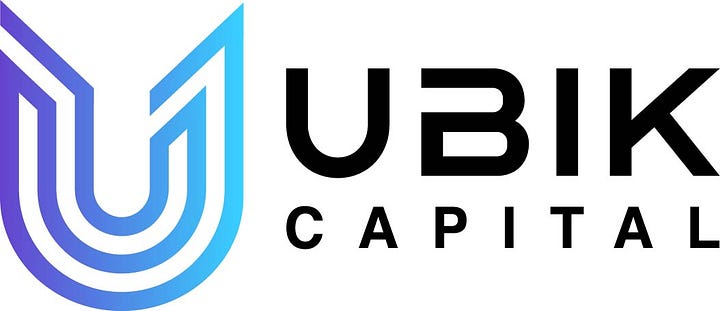
Capital is a Proof-of-Stake service provider, validator, and investor. Ubik Capital provides staking-as-a-service as well as investments to various blockchain projects. Ubik Capital secures major networks and is a trusted staking provider with years of industry experience.
We’d love to delegate to us!
Be a part of our community!
Website: https://ubik.capital/
Twitter: https://twitter.com/ubikcapital
Telegram: https://t.me/ubikcapital
Discord: https://discord.gg/9Jzbk4MZPF
E-mail: contact@ubik.capital
Disclaimer: Not financial advice. Cryptocurrency and blockchain investments are high risk, can incur substantial losses, and are not suitable for everyone. Please consult a professional before considering investment in any cryptocurrency. This article does not encourage or support any specific investments, use of applications or technology, or financial direction. This article is for informational purposes only and should be verified and validated externally for 100% accuracy.